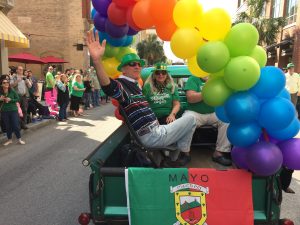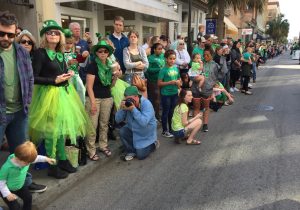
Shaun Doherty in Fitzgerald’s pub, Glasthule, Dublin, 2018
Shaun Doherty died just before Thanksgiving this year. He was the first and best friend of Irish and Irish American Studies.
I don’t remember when I first met Shaun. I thought it was at a screening of The Wind That Shakes the Barley that Moore Quinn arranged on campus, but Shaun’s wife, Eimer Kernan, reminded me that was when I first met her. Apparently, I’d known Shaun for years already. It happened sometime back there in the mythic past. It seems I always knew him.
Shaun had the look of an Irish poet. Tall, thin, a wood-hard handshake. Nothing mystical though or druidic. He was more like common sense grown into a post oak. Maybe a better comparison is the hardwood cane Shaun carried in the last couple of years. It was carved out of blackthorne by Willie O’Brien, a friend of Eimer’s father, Desmond Kernan. O’Brien was a barber with a shop in Goatstown, Co. Dublin. Blackthorne is hardy, and its wood grows harder as it gets older. The cane is straight and gnarled and hard, and it puts one in mind of sunny seascapes seen from the slopes behind Dún Laoghaire.
Shaun joined several different classes that I taught—from Modern Literature to Irish Studies to First Year Writing. I can’t tell you how many classes over the years, because his presence became a fixed part of campus. I am told he was one of the longest-attending students at the College of Charleston. I believe it. He was friendly as the park bench that sits outside the English department, and sage as the oaks that give it shade.
He and I are both transplants. I think our backgrounds made an easy bond between us. I never told him this, but he might have been my dad’s younger brother. Our families came from the same place, the New York Irish. They played stick ball swinging broom sticks for bats. They practiced fastballs by throwing rocks in the Hudson River. They watched the professionals at the Polo Grounds. Shaun was my favorite uncle.
Our talks usually went for an hour or more. He told me about Vietnam, about corporate America, about the restaurant business, but always about people. The sergeant who knew how to handle a near race-riot. There was one story of a corporate executive dressing Shaun down and another guy standing behind the man miming for Shaun, who was about to set the man straight, to keep his mouth closed. The point of the story was the friend, not the exec. Discretion on that occasion led to a great job oversees—was that when he went to live in Ireland? I don’t remember. I wish Shaun were here for me to ask. There’s so much to ask him.
Last year, one of my undergraduate students interviewed him for our new Irish Oral History Project. I’m so glad he did. We’ve got about 60 minutes of stories that will soon be available to the public through the Lowcountry Digital Library at CofC. When I listened to the tape, I jotted down a dozen follow-up questions. I wanted to ask more about so many things. I miss him.
Shaun had a genius for people—for recognizing and responding to the humanity in others. Last Spring, one of my young students mentioned that he had served with the Marines in Iraq. Shaun quietly went up to him after class. Though more than fifty years separated them, they talked quietly and earnestly, veteran to veteran, brother to brother. One of my prouder boasts in life is that Shaun thought enough of me to make me a friend. I’m no Marine. I’d done nothing to earn that bond, but he gave it to me anyway.
In one of my classes we were studying W. B. Yeats, who, because he came of Protestant Ascendency stock, was always trying to prove his Irishness. “Know that I would accounted be,” he insisted, “True brother of a company/ That sang, to sweeten Ireland’s wrong/ Ballad and story, ran and song.” I think Yeats’ “To Ireland in the Coming Times” inspired Shaun, who was himself an accomplished poet, to write this:
Not a Gael you say, but
Anglo Saxon to the bone.
Forget you these Sceptered Isles
were one time Gaelic all?
Gael, Northman, Norman, Saxon
mixed on this ancient soil,
though oft in battle toiled.
Did not this blood watered isle
breath into all the notion of herself?
Mystical, shifting layers,
bardic ballad, Nordic rune
mixed, became a single tune.
Yeats caught it all
and put to verse
the mystery of this isle
that has a notion of herself.
Who, though the language fades,
seduces most who shelter here.
Anglo Saxon, by blood maybe,
but as generations passed
the language of the soil took hold
and this “west brit” became
the golden trumpet of her soul.
By such did Yeats prove
Irishness is tethered
to the place, not
in the bone.
It has the rhythm of a Yeats poem, and it’s just as hard. Rhyming “hold” and “soul” is just like Yeats. Now, Shaun was a head above the heads of most of my students, and he suspected they might not understand the poem. Luckily, he provided his own notes to help his classmates. (Yeats did that too. You can find Shaun’s at the bottom of this tribute.)
I don’t want to explicate the poem now. But I want to latch on to one thing, that final image, which expresses the generosity I saw in Shaun’s spirit. Everyone could be his sister or his brother. Or his nephew. My bones were not tethered to his. He was not my uncle. I did not have that privilege. But I was rooted to Shaun, like the tree in another Yeats’s poem and like the oak tree outside my office window, through this dear perpetual place.
Shaun’s notes:
Gael/Gaelic – An early name given to the Irish based on their language, e.g. they spoke Gaelic, as the English spoke English, the French spoke French, etc. Chesterton refers to the “Great Gaels of Ireland” in his epic poem, “Ballad of the White Horse”.
Sceptered Isles – reference to England/Scotland/Wales and Ireland.
Runes – A Germanic alphabet used by Vikings, Angles and Saxons before the adoption of the Latin alphabet. First known inscription on stone 150 AD (Wikipedia).
West Brit – Slang name given by the native Irish to the Anglo Irish Ascendency class. They can be distinguished by their “plumy” accent, similar to the English upper class.



















